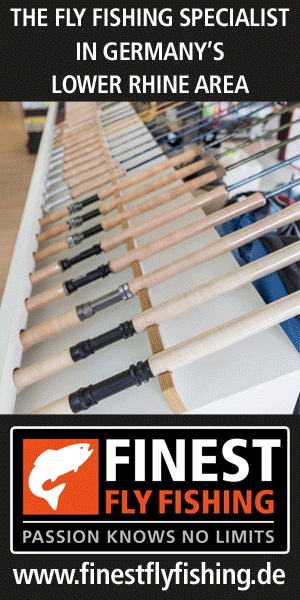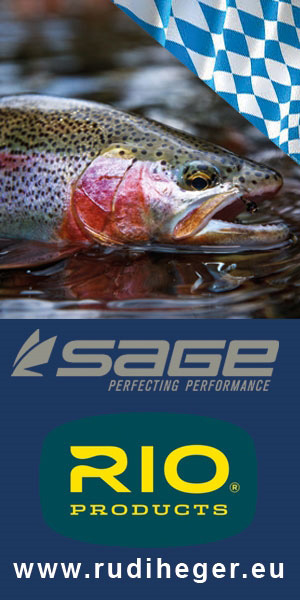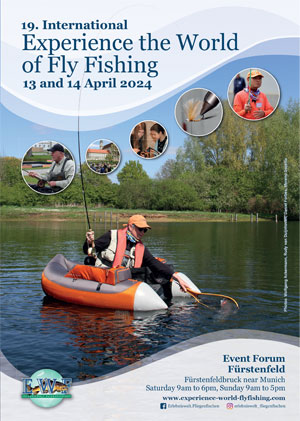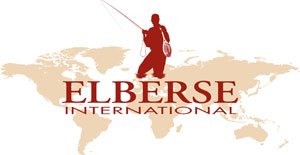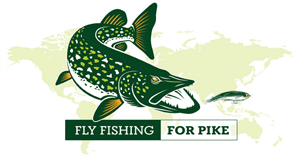A style and method of fly-casting developed out of the need to quickly dry the fly lines used in the old days. After reading this, you will probably make a turn as well…

In the years before the development of the plastic fly lines, Hans Gebetsroither – working as a guide on the Gmundner Traun in Austria – needed to dry the silk lines used in those days quickly so he could grease them once more. Several times during a day’s fishing of the people he was guiding, he would have to repeat this process. The lines were back on the reels and in order to lengthen them, Hans would pull line of the reel while at the same time making a circular movement with his rod tip. The turns got slower when the line got longer, but the circular movement remained. In this way Hans found he could dry the lines in the quickest possible way. These days, one of the advantages of the Gebetsroither style of casting is indeed that one can bring the line to the correct length very quickly, more so than with a normal overhead cast.
Instead of using the wrist or elbow for casting, with the Gebetsroither style the movement comes from the shoulder. This results in the rod hand making a circular movement, with no real stops to lengthen the line on the forward or backward cast.

The Gebetsroither style is much more a continuous movement, one of the reasons why we can lengthen the fly line more quickly as opposed to the normal style of casting. One big disadvantage of the normal style of casting is that the fly line goes down on the back cast, with the “Austrian” or “Belgian*” style as it is sometimes called too, the line actually goes up behind the caster. Because of the circular movement of the rod hand, the fly line travels below the rod tip on the back cast and than moves in an upward direction. This is followed by the line travelling over the rod tip on the forward cast and slowly sinking down to the water surface when the final presentation is made.
* One Belgium caster, as far as I know, demonstrated this style of casting for the first time at some American fly fishing shows, which is why some people still call it ‘Belgium style’.
Do not stop
With the normal style of casting most of the movement comes preferably from the elbow, whereby the wrist is used to make a really nice sudden stop. A lot of anglers will use the wrist too much though, which results in a much worse style of casting, plus a higher chance of injuries in that part of the arm too. With the Gebetsroither style of casting, as I said before, all of the movement comes from the shoulder, the wrist is not really used at all because there is no real stop in this case. A lot of people have problems with this stop anyway. The stop is too brisk, too much energy is used, they slam the rod more than just making a sudden stop with it (because that is really all that it takes). Using too much energy in making that stop, results in the rod tip moving down sharply (actually slowing down the line) and extra waves are send down the line just behind the loop. After learning the Gebetsroither style of casting a lot of people find they will use less energy in casting, without sacrificing distance. One reaches the same distance with a lot less energy and therefore without getting tired quickly.

The Gebetsroither style of casting has the name that one needs short and fast fly rods for it. This is not really the case, even with a slow eight foot rod for a number #3 weight line one can use this technique to bring the fly to the target quickly. Personally I would not use it when I want to achieve really long distances, because the line travels below the rod tip on the back cast, it will often hit the surface than somewhere near you. Because of that you will loose your control over the long length of fly line that you are trying to keep in the air. Using a double haul is a big help with the Gebetsroither style of casting. You will get more speed in the line, whereby it will cut through the wind much better. It is also a big help when you are trying to lengthen the line quickly.

The Austrian style of casting can be imparted into a lot of different casts. Bow casts can be made just as easy with this style as with the ‘old English’ style. The same applies to a normal parachute cast, reach cast, backhand casts and when casting with a lot of accuracy at short distances. The Gebetsroither parachute cast is a little different form a normal parachute cast. One starts with making normal casts parallel to the water surface or bottom. The angle of casting is than changed in such a way that the line travels lower behind us and much higher in front of us. On the final cast the line is shot high into the air in front of us and our rod tip is brought down immediately. This has the effect that the whole line lands on the water softly and in a lot of small curves. The nymph we are fishing will sink down without any resistance; a dry fly will float a considerable distance before it starts to drag.

Hans Ruedi Hebeisen worked closely together with Hans Gebetsroither for many years and at his schools and courses he still teaches his pupils, together with his wife Heidi, in that style of casting. Erhard Loidl, Roman Moser and Günter Feuerstein are just a few of the people who are doing courses or teach in this style of casting as well.

